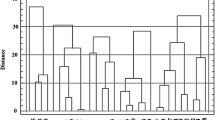Abstract
Narrow-leafed lupin (Lupinus angustifolius L.) is a grain legume well-adapted to sandy acid soils in a Mediterranean climate. Improved metribuzin tolerance in lupin cultivars is considered essential to protect crops from herbicide damage in Australia. This paper reports on the inheritance of metribuzin tolerance in two induced mutants Tanjil-AZ-33 and Tanjil-AZ-55 over the susceptible wild type cv. Tanjil. Both mutants were highly tolerant to 800 g/ha metribuzin with no foliage damage, but cv. Tanjil died and reciprocal F1 hybrids had intermediate tolerance with foliage damage. The F2 populations of both crosses, Tanjil-AZ-33 × Tanjil and Tanjil-AZ-55 × Tanjil, had a segregation ratio of 1:2:1 for highly tolerant: damaged:dead plants. Progeny tests (F3) of selected F2 single plants confirmed that highly tolerant F2 plants were homozygous and damaged F2 plants were heterozygous. Clearly a single semi-dominant gene conferred metribuzin tolerance in both mutants. An allelism test revealed that the two mutants had two non-allelic tolerance genes with F2 plants segregating in a 15:1 ratio for survival and death at 800 g/ha metribuzin. The tolerance gene in Tanjil-AZ-33 was designated as Mt3 and the gene in Tanjil-AZ-55 as Mt5. At 4,000 g/ha metribuzin, 1/16 of F2 plants from the cross between the two mutants had no herbicide damage, suggesting the additive effects of the two tolerance genes, whilst the rest were damaged or dead. Combining these two tolerance genes, Mt3 and Mt5, increased tolerance further by approximately five-fold.


Similar content being viewed by others
References
Al-khatib K, Libbey C, Kadir S, Boydston R (1997) Differential varietal response of green pea (Pisum sativum) to metribuzin. Weed Technol 11:775–781
Auld DL, Mahler KA, Thrill DC, Erickson DA, Raymer PL, Sernyk JL (1991) Registration of two rapeseed germplasm populations. Crop Sci 31:493–494
Barrentine WL, Hartwig EE, Edwards CJ Jr, Kilen TC (1982) Tolerance of three soybean (Glycine max) cultivars to metribuzin. Weed Sci 30:344–348
Beversdorf WD, Kott LS (1987) Development of triazine resistance in crops by classical plant breeding. Weed Sci 35 (Supplement 1), 9–11
Bowran D, Hashem A (2008) The role of weed management in sustaining systems for lupin production. In: Palta JA, Berger JD (eds) Proceedings of the 12th international lupin conference, 14–18 September 2008, Fremantle, Australia, pp 11–14
Edwards CJ Jr, Barrentine WL, Kilen TC (1976) Inheritance of sensitivity to metribuzin in soybeans. Crop Sci 16:119–120
Falb LN, Smith AE (1984) Metribuzin metabolism in soybeans. Characterization of the intraspecific differential tolerance. J Agr Food Chem 32:1425–1428
Fedtke C, Schmidt RR (1983) Behaviour of metribuzin in tolerant and susceptible soybean varieties. In: Miyamoto JK, Kearney PC (eds) Proceedings of 5th international congress of pesticide chemistry, Oxford, UK, pp 177–182
Frear DS, Mansager ER, Swason HR, Tanaka FS (1983) Metribuzin metabolism in tomato: isolation and identification of N-glucoside conjugates. Pesticide Biochem Physiol 19:270–281
Frear DS, Swason HR, Mansager ER (1985) Alternate pathways of metribuzin metabolism in soybean: formation of N-glucoside and hologlutathione conjugates. Pesticide Biochem Physiol 23:56–65
Hirschberg J, Yehuda AB, Pecker I, Ohad N (1987) Mutations resistant to photosystem II herbicides. In: von Wettstein D, Chua NH (eds) Plant molecular biology. Plenum Press, New York, pp 357–366
Jursinic PA, Pearcy RW (1988) Determination of the rate of limiting step for photosynthesis in a nearly isonuclear rapeseed (Brassica napus L.) biotype resistance to atrizine. Plant Physiol 88:1195–1200
Kilen TC, He G (1992) Identification and inheritance of metribuzin tolerance in wild soybean. Crop Sci 32:684–685
Kleemann SGL, Gill GS (2007) Differential tolerance in wheat (Triticum aetivum L.) genotypes to metribuzin. Aust J Agr Res 58:452–456
Newhouse KE, Singh BK, Shaner DL, Stidham MA (1991) Mutation in corn (Zea mays L.) conferring resistance to imidazolinone herbicides. Theor Appl Genet 83:65–70
Newhouse KE, Smith WA, Starrett MA, Schaefer TJ, Singh BK (1992) Tolerance to imidazolinone herbicides in wheat. Plant Physiol 100:882–886
Perry MW, Dracup M, Nelson P, Jarvis R, Rowland I, French RJ (1998) Agronomy and farming systems. In: Gladstones JS, Atkins C, Hamblin J (eds) Lupins as crop plants, biology, production and utilization. CAB International, Wallingford, UK, pp 291–338
Sebastian SA, Fader GM, Ulrich JF, Forney DR, Chaleff RS (1989) Semidominant soybean mutation for resistance to sulfonylurea herbicides. Crop Sci 29:1403–1408
Si P, Walton GH (2004) Determinants of oil concentration and seed yield of canola and Indian mustard in the lower rainfall areas of West Australia. Aust J Agr Res 55:367–377
Si P, Sweetingham MW, Buirchell B, Bowran D, Piper T (2006) Genotypic variation on metribuzin tolerance in narrow-leafed lupin (Lupinus angustifolius L.). Aust J Exp Agr 46:85–91
Si P, Buirchell B, Sweetingham MW (2009a) Improved metribuzin tolerance in narrow-leafed lupin (Lupinus angustifolius L.) by induced mutation and field selection. Field Crops Res 113:282–286
Si P, Buirchell B, Sweetingham MW (2009b) Induced mutation in narrow-leafed lupin improvement: an example of herbicide tolerance. In: Shu QY (ed) Induced plant mutations in the genomics era. Food and Agriculture Organization of the United Nations, Rome, pp 85–87
Smith AE, Wilkinson RE (1974) Differential absorption, translocation and metabolism of metribuzin [4-amino-6-tert-butyl-3(methylthio)-as-triazine-5 (4H)one] by soybean cultivars. Physiol Plant 32:253–257
Swanson EB, Herrgesell MJ, Arnoldo M, Sippell DW, Wong RSC (1989) Microspore mutagenesis and selection: canola plants with field tolerance to the imidazolinones. Theor Appl Genet 78:525–530
Villarroya M, Escorial MC, Garcia-Baudin JM, Chueca MC (2000) Inheritance of tolerance to metribuzin in durum wheat. Weed Res 40:293–300
Acknowledgments
This research was funded by the Grains Research and Development Corporation (GRDC) of Australia. GP was awarded an Australian Endeavour Post-Doc Fellow at CLIMA for 6 months. We are grateful to John Quealy for his technical support and Prof Erskine for his comments on an earlier version.
Author information
Authors and Affiliations
Corresponding author
Rights and permissions
About this article
Cite this article
Si, P., Pan, G. & Sweetingham, M. Semi-dominant genes confer additive tolerance to metribuzin in narrow-leafed lupin (Lupinus angustifolius L.) mutants. Euphytica 177, 411–418 (2011). https://doi.org/10.1007/s10681-010-0278-9
Received:
Accepted:
Published:
Issue Date:
DOI: https://doi.org/10.1007/s10681-010-0278-9




